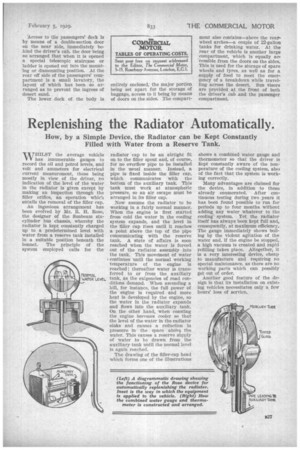Replenishing the Radiator Automatically.
Page 11

If you've noticed an error in this article please click here to report it so we can fix it.
How, by a Simple Device, the Radiator can be Kept Constantly Filled with Water from a Reserve Tank.
WHILST the average vehicle has innumerable gauges to record the oil and petrol levels, and volt and ammeters for electrical current measurement, these being mostly in view of the driver, no indication of the level of the water in the radiator is given except by making an inspection through the filler orifice, an operation which entails the removal of the tiller cap.
An Ingenious arrangement has been evolved by Mr. R. H. Rose, the designer of the Sunbeam sixcylinder bus chassis, whereby the radiator is kept constantly charged up to a predetermined level with water from a reserve tank installed in a suitable position beneath the bonnet. The principle of the system employed calls for the radiator cap to be an airtight fit on to the filler spout and, of course, for no overflow pipe to be installed in the usual manner. Instead, a pipe is fixed inside the filler cap, which communicates with the bottom of the auxiliary tank. This tank must work at atmospheric pressure, so an air escape must be arranged in its filler cap.
Now assume the radiator to be working in a fairly normal manner. When the engine is first started from cold the water in the cooling system expands, and the level in the filler cap rises until it reaches a point above the top of the pipe communicating with the reserve tank. A state of affairs is soon reached when the water is forced out of the radiator assembly into the tank. This movement Of water ! continues until the normal working temperature of the engine is reached ; thereafter water is trans-! f erred to or from the auxiliary tank, as the exigencies of road conditions demand. When ascending a hill, for inStance, the full .power a the engine is required and more heat is developed by the engine, so the water in the radiator expands and flows into the auxiliary tank. On the other hand, when coasting the engine beeninOs cooler so that the level of the water in the radiator sinks and causes a reduction in pressure in the space above the water. This causes a reserve supply of water to be drawn from the auxiliary tank until the normal level is again reached.
The drawing of the filler-cap head which forms one of the illustrations
shows a combined water gauge and thermometer so that the driver is kept constantly aware of the temperature of the cooling system, also of the fact that the system is working correctly.
Many advantages are claimed for the device, in addition to those already enumerated. After continuous testing during two -years it has been found possible to run for periods up to four months without adding any water whatever to the cooling. system. Yet the radiator itself has always been kept full and, consequently, at maximum efficiency. The gauge immediately shows boiling by the violent agitation of the water and, if the engine be stopped, a high vacuum is created and rapid refilling takes place. Altogether, it is. a .very interesting device, cheap to manufacture and requiring PO special maintenance, as there are no working parts which can possibly get out of order.
Another good feature of the design is that its installation on existing vehicles necessitates only a few hours' loss of service.


































